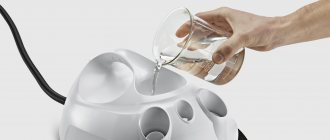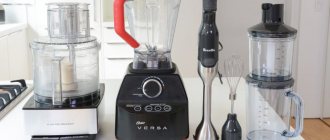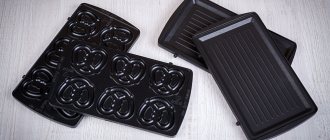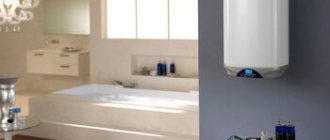The main requirement for ironing – clothes should acquire a presentable appearance quickly, without damage, and the device itself should be convenient and not difficult to use.
And a household steam generator , despite some shortcomings, meets these requirements to a greater extent than an improved iron with a steamer.
Let's look at the advantages and disadvantages of the devices to understand which is better.
Page navigation:
Iron Features
You should know! An iron is a household appliance designed to smooth out wrinkles and wrinkles on clothes and linen.
The principle of operation of the device involves heating the sole of the device, with the help of which the fabric is smoothed.
Modern appliances are predominantly powered by electricity.
Although there are also compact road models that run on batteries and have limited functionality.
The most widely used irons are those equipped with a water tank , which is designed to generate steam , which greatly increases the efficiency of ironing.
Many models have a “steam boost” function - usually this is an additional button on the handle of the device, when pressed, steam under high pressure is supplied to the surface of the fabric.
This helps smooth out very wrinkled, dense and overdried fabrics and even straightens out accidentally ironed folds.
Keep in mind! The iron is a widely used appliance that has proven itself very well over years of regular use.
pros
- as a rule, low price : even multifunctional and expensive models are quite affordable for purchase;
- familiarity : the basic operating principle of the device has not changed for decades, and additional functionality is organically integrated into the long-familiar procedure for using the iron;
- When disconnected from the electrical source, the device does not cool down immediately. Therefore, for a certain period of time it can still be used to smooth out fabric, for example, located away from sockets;
- The functionality of modern irons is quite comparable to most of the capabilities of a steamer. For example, by turning on the “steam” function with the device, it is quite possible to smooth out hanging curtains or refresh furniture coverings;
- makes perfect creases on trousers , smooths out wrinkles well without additional equipment;
- smoothes bed linen well (if the length of the ironing board allows you to lay out a sheet or duvet cover without folding it in half);
- The device is quite easy to clean using a damp cloth or a cleaning stick.
Minuses
- The main disadvantage of the iron is possible damage to the material due to incorrectly selected temperature . In the worst case, this leads to holes in things, and in a more acceptable case, it leads to excessive shine of the fabric;
- the device will be of little help in smoothing things decorated with accessories, buttons , and every housewife has probably had plastic buttons melted during the ironing process;
- an iron to smooth out small folds, pleating, stitched gathering on the cuff fabric in the form of a “pipe”, etc., it is also difficult to smooth out shoulder seams, for example, in jackets;
- the device requires an ironing board or other flat, stable surface covered with a material that can withstand high heat and “does not stick” to the surface of fabrics;
- the standard cord length of this device is usually short, that is, it can only be used near sockets ;
- Since the water reservoir is built into the iron itself, the weight of the iron increases significantly when water is poured into it.
To choose a good device, see the rating of the best irons.
Principle of operation
The operating principle of the iron without various regulators and additives is as follows:
- After turning on the device, the heating element spiral begins to heat up, which leads to an increase in the temperature of the soleplate of the iron.
- As the sole warms up, the temperature of the water intended for steam generation also increases.
- Some models of devices are equipped with regulators, electronic components that can prevent the formation of scale or automatically regulate the temperature of the soleplate without your intervention.
Like an iron, a steam generator has a heating element that turns water into steam when heated. The devices differ in that the steam generator is equipped with components that independently regulate the temperature and pressure of the steam in the device.
Features of the steam generator
A household steamer is a lightweight iron, the stand for which is a steam generator , usually small in size .
Stay up to date! To generate hot steam, with the help of which the device smoothes things, water is supplied by a steam generator through a hose directly into the iron.
Externally, a household steamer looks like a small vacuum cleaner with a thin supply hose , and the steam button is usually located on the body of the iron itself.
Many standard steam generators are equipped with a folding bar (hanger) for easy placement of ironed clothes.
Compact steamers that do not have a supply hose and a built-in hanger are also widespread.
For such devices, which look like an electric kettle, the steam generator is built directly into the body.
The wide functionality of a household steam generator allows it to be used not only for ironing clothes, but also for steaming curtains, tablecloths, cleaning carpets and furniture coverings , for treating kitchen surfaces and cleaning the house.
pros
- great capabilities and high functionality : irons and cleans not only clothes and linen, but also other fabrics - curtains, tablecloths, carpets, etc.;
- many models can be used for cleaning an apartment - for cleaning sofas, kitchen surfaces, ceilings;
- Some models can gently clean windows, mirrors and other glass surfaces;
- eliminates not only wrinkles, but also odor, “refreshes” clothes without washing;
- equally well in both vertical and horizontal positions ;
- high temperature of the steam, which allows you to quickly smooth even natural materials that are difficult to iron - what is considered a “thermal shock” for an iron, is a normal operating mode for a steam generator;
- no ironing board required;
- calmly steams things with buttons, snaps, fittings , etc. (which can be treated with steam);
- does not damage the material;
- The iron itself, which is used for ironing, is light in weight ;
- can iron thick fabric or fabric folded several times;
- large water tank - you can be less likely to be distracted from the ironing process.
Minuses
- high price;
- bulky and usually heavy;
- makes noise when working;
- high risk of steam burn due to careless handling;
- requires space for storage and use;
- consumables are required - filters, cartridges, etc.;
- works only when plugged into a power outlet;
- does not work well in a vertical state, even in the “steaming” mode;
- compact steamers usually have a small water tank volume and low steam output . This does not allow them to be used for long-term ironing of a large number of things;
- It is difficult to make folds and arrows ; additional devices will be required.
To choose a good device, see the rating of steam generators.
Steam ironing systems
Steam ironing systems, or steam stations, are an iron with a steam generator as a stand. The container for pouring liquid is located separately, since it is 3 times larger than that of classic ironing devices. And the steam supply is 4 times more powerful than usual.
If a regular iron is usually used only horizontally, then the steam station allows you to do vertical steaming. The ironing process is significantly accelerated - in one motion you can process several pillowcases or a folded duvet cover at once.
Advantages of the devices:
- It is not necessary to use an ironing board for the process. The item can be put on a hanger and steamed vertically.
- There is no need to stop frequently to add water, since the tank holds more than two liters at once.
- The water is heated in batches and turns into steam. You can start working within 2 minutes after switching on.
- It is not necessary to use distilled water; tap water is fine.
- There is no need to regulate the temperature, focusing on the characteristics of the fabric from which the product is made.
- The base of the iron is easy to clean if necessary. And on the fabric surface it glides easily and freely.
- In such a device, scale does not form, since there are filters that protect against foreign impurities, and the liquid is heated to a vapor state.
- As a rule, the device is equipped with a practical handle that has a special button for releasing steam, which greatly simplifies the operation and maintenance of the unit.
Flaws:
- price category of the device;
- an iron in a steam ironing system weighs up to 1 kg;
- steam generator weight;
- There must be a stable surface for installation.
What is best to use and when?
What is the difference? At home, both a steam generator and an iron perform similar functions.
But in some situations, using one of the devices is preferable, for example:
Iron
- will help to make high-quality “arrows” on trousers, form folds on a skirt;
- folding irons are convenient to take with you on trips;
- oddly enough, modern models often show better results in ironing quality tests;
- The device is familiar and therefore more convenient to use.
Steam generator
- can clean carpet, upholstered furniture, fabric coverings;
- allows you to straighten hanging curtains and drapes;
- helps to carry out high-quality cleaning of the room without the use of chemicals;
- washes windows and glass surfaces (not all models);
- refreshes clothes well;
- steams almost any fabric, including thick and multi-layered ones.
Let's consider the pros and cons
It is worth taking a closer look at all the positive and negative features of each device in order to make the right choice.
Iron
The advantages of the iron are as follows:
- price. There are models of different price categories, both budget options and quite expensive ones. Everyone can find a suitable model;
- mobility and compactness. The iron is much smaller and lighter.
The disadvantages include:
- it takes longer to smooth out the fabric;
- ironing quality. The iron is significantly inferior to the steam generator.
Steam generator
The benefits include:
- using dry steam instead of wet steam;
- the high temperature of the device allows you to iron even fabric that has been folded in several layers with high quality;
- ironing speed. The process is much faster than when using an iron;
- large volume of water tank. No need to constantly add water;
- Suitable for delicate items and thick materials;
- The control panel allows you to configure the steam generator. You can turn off the steam and use it like a regular iron;
- can be used in various positions, not only horizontally.
The disadvantages include:
- price. Significantly higher than that of an iron;
- dimensions. Due to its design, the steam generator is quite large.
What is better: a steam generator or an iron with a steamer?
Important! When deciding to purchase a device, you should first familiarize yourself with its technical capabilities and test results.
You need to pay special attention to the functionality that the owner requires.
An iron should be preferred if:
- requires ironing of a large amount of linen, including bed linen;
- Most of the clothes belong to the classic style, that is, the formation of folds and “arrows” is necessary;
- the floor and wall coverings of the apartment are not resistant to hot steam (for example, laminate is laid on the floor), that is, the device is not intended to be used for cleaning;
- For the housewife, such indicators as the quality of ironing and ease of use are important. Since the tests carried out show that according to these indicators, irons are still ahead of steamers.
It is worth purchasing a steam generator if:
- it is planned to use all (or almost all) of the functionality of the device. In addition to ironing clothes using a steamer, it is planned to clean carpets and floor coverings, treat kitchen and other surfaces, clean furniture, smooth curtains and outerwear made of thick fabrics (for example, coats);
- most clothes do not require “arrows” and folds;
- items made of “complex” (cotton, linen, other natural fabrics) or openwork fabrics (lace, guipure, embroidery) predominate;
- there are many things equipped with buttons, buttons and other accessories;
- the owner is a person striving to master new devices and devices.
Steamer
Reference! This device consists of a steam generator, a water container equipped with a heating element that brings the liquid to a boil, and special nozzles.
The device allows you to process not only wardrobe items, but also carpets, curtains, upholstered furniture, blankets, mattresses, plush toys .
Hot steam not only smoothes the fabric, but also disinfects it. It destroys dust mites and other harmful microorganisms that can live in textiles.
pros
Modern steamers have the following advantages:
- Steam has a more gentle effect on fabric than the heated soleplate of an iron. You can iron things with decorative elements: rhinestones, beads, stickers, etc. The steam generator cannot set the material on fire, change its structure or leave creases. A large assortment of attachments allows you to work with even the most delicate products that require special care.
- The boiler holds up to 2.5 liters of water , so you don’t have to worry about running out of liquid.
- Thanks to the steamer, you can not only get rid of wrinkles, but also remove dried stains , for example, from stuck chewing gum.
- For vertical processing of clothes, an ironing board is not required.
- Steam rids the fabric of odors of tobacco, sweat , etc.
- You can put your wardrobe items in order faster than using an iron. At the same time, there are no folds in hard-to-reach places, for example, near seams and buttons.
- In order to straighten the curtains, you do not need to remove them from the curtain rod .
The power cord is connected to the boiler, from which a steam hose with an additional cable extends.
As a result, you can move up to 3 m away from the outlet.
Minuses
Keep in mind! Despite its functionality, the steam generator also has disadvantages:
- Hand steamers should not be turned over , otherwise you may get burned. This should be taken into account if the device is used by children.
- It is believed that a standard steamer does a worse job with linen and cotton clothes than an iron . For natural fabrics, it is recommended to purchase a powerful device.
- Manual models are designed for only 15-20 minutes of continuous operation , and stationary ones have a vertical stand 180 cm high. To accommodate it, you will have to allocate enough space in the apartment.
- A modern steamer is quite expensive.
About choosing an iron according to criteria
To buy an iron, you need to decide on the purpose of its use, and in addition, you should decide on the technical criteria that will determine the choice.
- Power (operating power range, power adjustment).
- Functionality (constant steam supply, its supply intensity, water tank volume).
- Level of protection (from scale, fire).
- Material for making the sole.
- Convenience (availability of replaceable soles, comfort of the handle, weight of the device).
All this will help you make the right choice among the many iron models.
Taking into account the criteria will allow you to resolve the issue of choosing an iron once and for all.
Advantages and disadvantages of an iron
Affordable price, allowing you to buy even an expensive multifunctional model.
Familiar general functionality that has not changed for a long time. Therefore, additional options are easier to master.
Slow cooling allows you to quickly smooth out items that are far from the outlet.
Many functions coincide with those of the steamer.
High-quality ironing of bed linen.
It is easy to clean from dirt.
Incorrect temperature selection can damage the fabric.
Ironing difficulties with a large number of accessories.
Difficulty ironing out small folds and shoulder seams.
You need an ironing board or other flat surface.
Short length of power cord.
How to choose
How to choose an iron with a steam generator, we make the right choice in favor of a quality device! We recommend that you carefully check all the characteristics of the product - do not stop at price alone. Pay special attention to the following parameters:
- Comfortable handle. Since the device is operated by hand, it is worth paying attention to the ergonomics of the handle - it should fit well in the palm, not have unnecessary parts and be made of non-slip material;
- Volume of the tank. Small containers are better suited for ironing things. By the way, it is better to choose a transparent tank (for example, made of plastic) to monitor the volume of water;
- Power. The optimal indicator ranges from 2000-2200 W. Lower power increases the processing time of the item and increases energy consumption;
- Steam pressure. It is better to choose a model with a peak pressure of 200-360 g per minute, a constant pressure of 80-14 g/min. The higher the pressure, the more rigid the tissues can be processed;
- Sole material. The surface must be durable and withstand mechanical stress, slide easily and evenly, heat up quickly, and also serve faithfully for a long time. More details here.
Now you know how to choose an iron with a steam generator if you decide to purchase such a device. Finally, let’s study the reviews of which is better – a steam generator or an iron, provided by real people who have already made a purchase and were able to evaluate the performance characteristics.
What is the difference between an iron and a steam generator comparison
A steam generator is actually the same iron, but more powerful and functional. Large water tank allows continuous work for a long time.
Design
The differences between both devices are clearly manifested in their design. The iron will be considered first, since this device is familiar to everyone. Its design includes:
- Sole. Metal with various types of coatings. Coatings protect fabrics and improve slip.
- Thermostat. Sets the heating temperature for a specific fabric.
- Electrical cord in an insulating sheath.
- Steam supply. Improves the quality of ironing and speeds up its execution.
- Auxiliary components: steam generator, water container.
Iron heating element power (heater)
As for the power of the heating element, usually household economy-class irons have a gradation of heating element power in the range of 1500-1700 watts and 1800 - 2200 watts. Naturally, the more powerful the heating element, the faster the iron will heat up, and the speed of heating the water to create steam will also be higher. And most importantly, with such a powerful iron you can iron even thick coat fabrics. Apart from increased energy consumption and higher cost, powerful irons have no other disadvantages.
Which steam iron to choose depends primarily on the intensity of its use, the type of fabrics that you plan to regularly iron and your financial capabilities.











